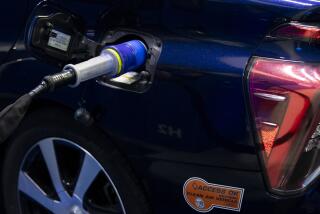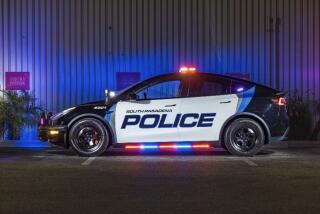In L.A., the driving becomes electric
When Lefteris, a professional photographer in Los Angeles, says his other car is a gas guzzler, he’s talking about the icon of environmentalists, the Toyota Prius.
Lefteris is part of a grass-roots movement of people who are fed up with the auto industry for not offering affordable all-electrical vehicles and who are building their own.
FOR THE RECORD:
Electric cars: An article on a homemade electric vehicle in Wednesday’s Highway 1 section listed the developer’s Web site address as www.Lefterisphot.com. It is: www.lefterisphoto.com. —
“It is possible,” say Lefteris, who goes by one name. “I didn’t do it for the cost savings, though it turns out to be an inexpensive way to transport myself. We must stop sending money to countries that are often hostile and repressive, and do something to save our fragile planet.”
The personal license plate on his blue Porsche makes the point: LKNOGAS.
If a photographer with some basic electrical and mechanical knowledge can do this in his garage, why can’t the best engineers in America do something similar? Where are the modern-day Henry Fords, mass producing vehicles that will keep the air cleaner, create manufacturing jobs and reduce the economic stranglehold that foreign oil has on our nation?
To be sure, the global auto industry is responding. Honda this month began producing a fuel-cell vehicle in Japan. But with its $600 monthly lease, it is no Model T for the masses. General Motors is working on the Volt, an electric vehicle with a backup gas engine, but it will not be available until 2010.
Lefteris’ vehicle, built on the frame and body of a 1971 Porsche 914, is not a hobby car. It’s his daily transportation for getting around L.A. In the last 12 months, he has put on 8,000 miles, making frequent business trips from his downtown L.A. studio to the Westside.
“My wife drives the gas guzzler, the Prius,” he said.
His car is packed with 22 lead acid batteries, a power controller, a charger and a 150-pound electric motor. The batteries are wired in series to produce 132 volts of direct current, and the motor puts out 20 horsepower, though the rating is calculated differently from a conventional gas engine.
The range is limited, but practical. Lefteris says the car can go up to 60 miles between charges, though running down the batteries shortens their useful life. The dashboard has electric power meters that he designed to provide information about the voltage of the battery array and the amount of amperage the motor is drawing. “You learn to coast a lot,” he says of his power-management driving style.
As we wove through downtown traffic, the two-seater demonstrated about the same zip as a typical four-cylinder gas economy car. It can top out at 90 miles per hour, but that speed would quickly drain the batteries. About 58 mph is the car’s sweet spot on the freeway.
The Porsche 914 is a good candidate for conversion, because it is lightweight and has a large amount of trunk space in the front and back for the electric system. The car has some drawbacks, such as no air conditioning or air bags, however.
At a time when many motorists are spending $100 to fill up their tanks, Lefteris says he spends about 1.5 cents’ worth of electricity for every mile. By comparison, a gas-powered vehicle that gets 20 miles per gallon would cost 23 cents a mile, based on $4.50 a gallon gas.
In many government parking areas, there are charging stations where the juice is free. I haven’t found any free government gas pumps lately.
And when automakers finally do start offering electric vehicles, it’s not clear who will be able to afford them. Lefteris spent about $18,000 to complete his vehicle, which is a lot cheaper than anything likely to hit the market soon.
Matt Miyasoto, who runs research and demonstration projects at the South Coast Air Quality Management District, said electric vehicle enthusiasts like Lefteris provide an important message for all of us.
“They have an emotional connection to what they are doing,” he said. “Having that kind of advocacy is important for the future of electric vehicles.”
About 1,000 such autos operate in California, a mix of fleet vehicles owned by electric utilities and homemade cars. SoCal’s electric enthusiasts meet once a month at the air quality district’s headquarters in Diamond Bar.
The federal government has sunk several billion dollars into battery research since the 1970s, said Ross Dueber, chief executive of ZPower, a Camarillo-based battery research company.
Batteries are limited by the laws of nature: The chemicals in them just don’t pack as much energy as gasoline, pound for pound, Dueber said. Current generational lithium ion batteries hold two to three times as much energy as lead acid batteries. But gasoline still has roughly 50 times more energy content than the best lithium ion battery.
Such a calculus doesn’t discourage the homemade electric vehicle movement. You can see their outpouring of creativity and commitment at www.evalbum.com, or go to www.Lefterisphoto.com.
What’s next? Lefteris now wants to cover his roof in solar panels and recharge his car batteries from the sun.
“We have so much energy falling on our heads,” he said “and we are not doing anything with it.”
More to Read
Sign up for Essential California
The most important California stories and recommendations in your inbox every morning.
You may occasionally receive promotional content from the Los Angeles Times.











